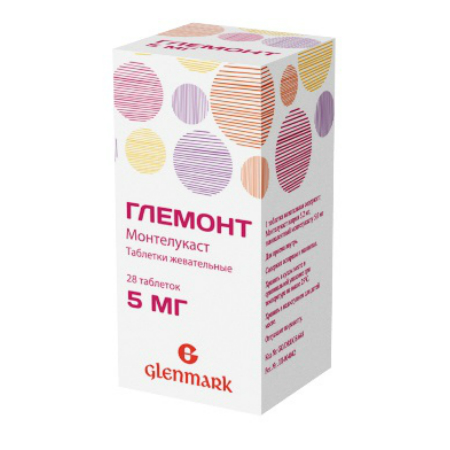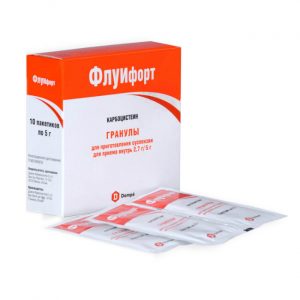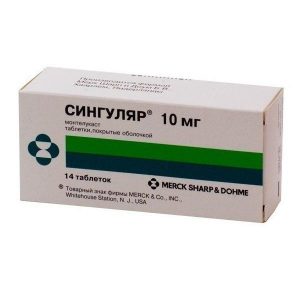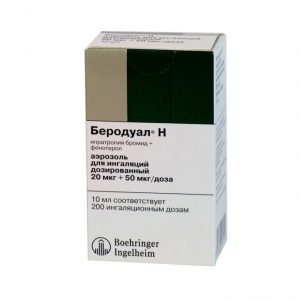Description
Pharmacological action
Cysteinyl-leukotrienes (LTC4, LTD4, LTE4) are strong mediators of inflammation – eicosanoids, which are secreted by different cells, including mast cells and eosinophils. These important pro-asthmatic mediators bind to cysteinyl-leukotriene receptors.
Type 1 cysteinyl-leukotriene receptors (CysLT1 receptors) are present in the human airways (including in the cells of the smooth muscles of the bronchi, macrophages) and other pro-inflammatory cells (including eosinophils and some myeloid stem cells). Cysteinyl-leukotrienes correlate with the pathophysiology of bronchial asthma and allergic rhinitis.
In asthma, leukotriene-mediated effects include bronchospasm, increased mucus secretion, increased vascular permeability, and increased eosinophils. In allergic rhinitis, after exposure to an allergen, cysteinyl-leukotrienes are released from pro-inflammatory cells of the nasal mucosa during the early and late phases of an allergic reaction, which is manifested by symptoms of allergic rhinitis.
An intranasal test with cysteinyl-leukotrienes has been shown to increase the resistance of the airways and nasal obstruction.
Montelukast is a highly active oral drug that significantly improves inflammation in bronchial asthma. According to biochemical and pharmacological analysis, montelukast with high affinity and selectivity binds to CysLT1 receptors without interacting with other pharmacologically important receptors in the respiratory tract (such as prostaglandin, cholinergic or -Adrenergic receptors).
Montelukast inhibits the physiological effect of the cysteinyl leukotrienes LTC4, LTD4 and LTE4 by binding to CysLT1 receptors without stimulating these receptors. Montelukast inhibits CysLT1 receptors in the airways, which is confirmed by the ability to block the development of bronchospasm in response to inhalation of LTD4 in patients with bronchial asthma. A dose of 5 mg is sufficient to relieve bronchospasm induced by LTD4.
Montelukast causes bronchodilation within 2 hours after ingestion and may supplement bronchodilation caused by 2-adrenergic agonists.
Pharmacokinetics
Absorption
After oral administration, montelukast is rapidly and almost completely absorbed. In adult patients, after taking chewable tablets in a dose of 5 mg on an empty stomach, the maximum plasma concentration (Cmax) is reached after 2 hours. The average bioavailability is 73%. After taking chewable tablets at a dose of 4 mg on an empty stomach in patients aged 2 to 5 years, Cmax is reached after 2 hours.
Distribution of
The binding of montelukast to plasma proteins is more than 99%. The distribution volume at equilibrium is on average 8-11 liters. Preclinical studies have revealed minimal penetration of montelukast across the blood-brain barrier. 24 hours after administration, the concentration of montelukast is minimal in other tissues.
Metabolism
Montelukast is extensively metabolized in the liver. When used in therapeutic doses, the concentration of montelukast metabolites in plasma in equilibrium in adults and children is not determined. In vitro studies have shown that CYP cytochrome P450 isoenzymes are involved in the metabolism of montelukast (3A4, 2A6, 2C8 and 2C9), while at therapeutic concentrations Montelukast does not inhibit CYP cytochrome P450 isoenzymes: 3A4, 2C9, 1A2, 2A6, 219. Metabolites have a minor therapeutic effect of montelukast.
Excretion of
Plasma clearance of montelukast in healthy adult volunteers averages 45 ml / min. After ingestion of radioactively labeled Montelukast, 86% of its amount is excreted in the feces for 5 days and less than 0.2% in the urine, which confirms that Montelukast and its metabolites are excreted almost exclusively with bile. The half-life of montelukast in young healthy adults is from 2.7 to 5.5 hours.
The pharmacokinetics of montelukast remains almost linear when ingested doses of over 50 mg. When taking montelukast in the morning and evening hours, differences in pharmacokinetics are not observed. When taking 10 mg of montelukast once a day, moderate (about 14%) cumulation of the active substance in plasma is observed. Pharmacokinetics of montelukast in different patient groups
Gender
The pharmacokinetics of montelukast in men and women is similar.
Elderly patients
With a single oral administration of 10 mg of montelukast, the pharmacokinetic profile and bioavailability are similar in elderly and young patients. The half-life of montelukast from plasma is somewhat longer in older people. No dose adjustment in the elderly is required.
Race
There were no differences in the clinically significant pharmacokinetic effects in patients of different races.
Hepatic insufficiency
In patients with mild to moderate hepatic insufficiency and clinical manifestations of liver cirrhosis, a slowdown in Montelukast metabolism was noted, accompanied by an increase in the area under the concentration-time pharmacokinetic curve (AUC) by approximately 41% after a single dose of the drug in a dose of 10 mg. The half-life of montelukast in these patients is slightly increased compared to healthy volunteers (average half-life is 7.4 hours).
Montelukast dose changes for patients with mild to moderate liver failure are not required. There is no data on the nature of the pharmacokinetics of montelukast in patients with severe hepatic insufficiency (more than 9 points on the Child-Pugh scale).
Renal failure
Since montelukast and its metabolites are not excreted in the urine, the pharmacokinetics of montelukast in patients with renal insufficiency have not been evaluated. No dose adjustment for this group of patients is required.
Indications:
Chewable tablets 4 mg. Prevention and long-term treatment of bronchial asthma in children aged 2 to 5 years, including: prevention of day and night symptoms of the disease.
Indications
Prevention and long-term treatment of bronchial asthma in children aged 6 to 14 years, including:
– prevention of day and night symptoms of the disease
– treatment of bronchial asthma in patients with hypersensitivity to acetylsalicylic acid
– prevention of bronchospasm,
load – relief of daytime and nighttime symptoms of seasonal and / or year-round allergic rhinitis in children aged 6 to 14 years.
Contraindications
– Hypersensitivity to any of the components of the
preparation – children under 2 years of age (for a dosage of 4 mg) and up to 6 years of age (for a dosage of 5 mg)
– phenylketonuria (contains aspartame).
Precautions: Pregnancy, period of breastfeeding.
Pregnancy and lactation:
Clinical studies of Montelukast in pregnant women have not been conducted. Montelukast should be used during pregnancy and duringbreastfeeding only if the expected benefit to the mother outweighs the potential risk to the fetus or child.
It is not known whether montelukast with breast milk is excreted. Since many drugs are excreted in breast milk, it is necessary to take this into account when prescribing montelukast during breastfeeding.
Special instructions
Enrofloxacin 50 injection should not be used simultaneously with bacteriostatic antibiotics (chloramphenicol, macrolides and tetracyclines), theophylline and NSAIDs.
Slaughter of pigs, cattle, sheep and goats for meat is permitted no earlier than 14 days after the last use of the drug. Meat of animals forcibly killed before the expiration of the specified period,
Patients with a confirmed allergy to acetylsalicylic acid and other non-steroidal anti-inflammatory drugs (NSAIDs) should not take these drugs during the treatment with montelukast, since montelukast, while improving respiratory function in patients with allergic bronchial asthma, nevertheless, cannot completely prevent the NSAIDs caused by them bronchoconstriction.
The dose of inhaled glucocorticosteroids (GCS) used simultaneously with montelukast can be gradually reduced under the supervision of a physician, however, a sharp replacement of inhaled or oral GCS with montelukast cannot be performed.
In patients taking montelukast, neuropsychiatric disorders have been described (see section “Side effects”).
Given that these symptoms may have been caused by other factors, it is not known whether they are associated with montelukast. The physician needs to discuss these adverse events with patients and / or their parents / guardians. Patients and / or their parents / guardians need to be explained that in case of such symptoms, it is necessary to inform the attending physician.
In rare cases, patients receiving anti-asthma drugs, including antagonists of leukotriene receptors, have experienced one or more of the following adverse events: eosinophilia, rash, worsening pulmonary symptoms, cardiological complications and / or neuropathy, sometimes diagnosed as Charge-Strauss syndrome, systemic eososis vasculitis. These cases were sometimes associated with a dose reduction or discontinuation of oral glucocorticosteroid therapy. Although a causal relationship between these adverse events and leukotriene receptor antagonist therapy has not been established, caution is required in patients taking montelukast. In such patients, appropriate clinical observation is necessary.
When reducing the dose of systemic glucocorticosteroids in patients receiving montelukast, caution should be exercised and appropriate clinical observation should be made.
The drug Glemont chewable tablets 4 mg and 5 mg, contains aspartame – a source of phenylalanine. Patients with phenylketonuria should be informed about the content of aspartame. The drug Glemont chewable tablets 4 mg and 5 mg is not recommended for use in patients with phenylketonuria.
Use in elderly patients
Differences in the efficacy and safety profiles of the drug, age-related patients not identified.
Impact on the ability to drive vehicles and mechanisms:
There is no evidence to show that montelukast reception affects the ability to drive a car or moving machinery. However, when using the drug, side effects such as dizziness and drowsiness may occur. In view of this, caution should be exercised when driving motor vehicles and performing actions requiring the speed of psychomotor reactions.
Composition
1 tablet chewable 5 mg contains:
Active ingredient:
montelukast sodium 5.2 mg
equivalent to montelukast 5.0 mg.
Excipients:
mannitol 201.35 mg,
microcrystalline cellulose 63.45 mg,
croscarmellose sodium 9.00 mg,
hyprolysis (hydroxypropyl cellulose) 9.00 mg,
aspartame 1.50 mg,
mg,
magnesium stearate 6.00 mg.
Dosage and administration of
The drug is taken orally once a day, regardless of food intake. The tablet can be swallowed whole or chewed before swallowing. Children take the drug under the supervision of adults. Glemont should be taken 1 hour before or 2 hours after a meal.
For bronchial asthma or bronchial asthma and allergic rhinitis: For children aged 2 to 5 years – 1 chewable tablet in a dose of 4 mg once a day in the evening.
For children aged 6 to 14 years – 1 chewable tablet in a dose of 5 mg once a day in the evening.
For allergic rhinitis: For children aged 2 to 5 years – 1 chewable tablet in a dose of 4 mg once a day and for children aged 6 to 14 years – 1 chewable tablet in a dose of 5 mg once a day individually depending on time the greatest exacerbation of symptoms.
Dose adjustment within these age groups is not required.
For the treatment of patients of other age groups, a different dosage form and dose of the drug are available – film-coated tablets, 10 mg.
General recommendations
The dose of the drug is the same for female and male patients. The therapeutic effect of montelukast on indicators reflecting the course of bronchial asthma develops during the first day. The patient should continue to take the drug, as during the period of achieving control over the symptoms of bronchial asthma, and during exacerbation of bronchial asthma.
For elderly patients, patients with renal failure, patients with mild to moderate hepatic impairment, as well as gender-specific special dose selection is not required.
There is no data on the use of montelukast in patients with severely impaired liver function.
The administration of montelukast along with other treatments for bronchial asthma
Montelukast can be added to the patient’s treatment with bronchodilators and inhaled glucocorticosteroids (GCS) (see section “Interaction with other drugs”).
Side effects
According to the World Health Organization (WHO), unwanted effects are classified according to their frequency of development as follows: very often ( 1/10), often ( 1/100 to <1/10), infrequently ( from 1/1000 to <1/100), rarely (from 1/10000 to <1/1000), very rarely (<1/10000) the frequency is unknown - according to the available data, it was not possible to establish the frequency of occurrence. Infectious and parasitic diseases: very common: upper respiratory tract infections. From the immune system: infrequently: hypersensitivity reaction, including anaphylaxis rarely: angioedema is very rare: eosinophilic liver infiltration. From the skin and subcutaneous tissue: often: rash infrequently: tendency to form hematomas, urticaria, pruritus very rarely: erythema nodosum, erythema multiforme. From the central nervous system: infrequently: headache, dizziness, drowsiness, paresthesia / hypesthesia, convulsions. Mental disorders: infrequently: sleep disturbances (including nightmares), insomnia, somnambulism, irritability, anxiety, agitation (including aggressive behavior or hostility), psychomotor hyperactivity (including irritability, anxiety and tremor), depression rarely: impaired attention, memory impairment very rare: hallucinations, disorientation, suicidal thoughts and suicidal behavior. From the cardiovascular system: rarely: palpitations. From the blood and lymphatic system: rarely: increased tendency to bleed. From the gastrointestinal tract (GIT): often: abdominal pain, diarrhea, nausea, vomiting, pancreatitis infrequently: dyspepsia, dry oral mucosa. On the part of the liver and biliary tract: often: increased activity of hepatic transaminases (alanine aminotransferase (ALT), aspartate aminotransferase, (ACT)) very rarely: hepatitis (including cholestatic, hepatocellular and mixed liver lesions). From the side of musculoskeletal and connective tissue: infrequently: arthralgia, myalgia (including muscle cramps). From the respiratory system: infrequently: nosebleeds are very rare: Charge-Strauss syndrome, pulmonary eosinophilia. Other: often: hyperthermia infrequently: asthenia / fatigue, malaise, swelling. During treatment with montelukast, the development of Charge-Strauss syndrome has been reported (see “Special Instructions”). Overdose Symptoms: There are no data on overdose symptoms when taking montelukast in patients with bronchial asthma at a dose of up to 200 mg per day for 22 weeks and at a dose of 900 mg per day for one week. There have been cases of acute overdose of montelukast (intake of at least 1000 mg of the drug per day) in clinical practice and during clinical trials in adults and children. Clinical and laboratory data indicated the comparability of montelukast safety profiles in children, adults and elderly patients. The most common side effects were thirst, drowsiness, vomiting, psychomotor agitation, headache, and abdominal pain. These side effects are consistent with Montelukast’s safety profile. Treatment: Treatment in case of acute overdose is symptomatic. There is no information on the specific treatment of Montelukast overdose. There is no evidence of the effectiveness of peritoneal dialysis or hemodialysis. Active ingredient Montelukast pharmacy terms of sale Prescription Dosage form tablets chewable




